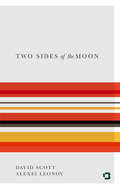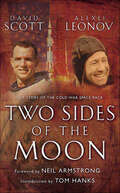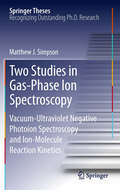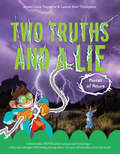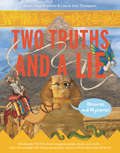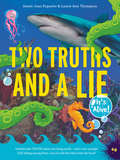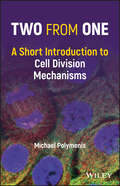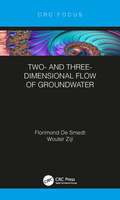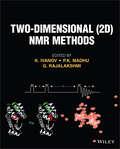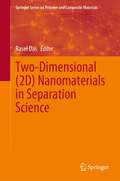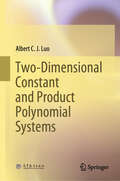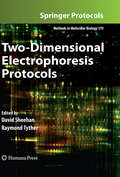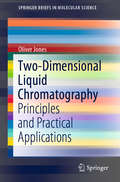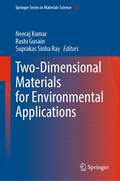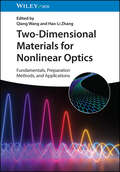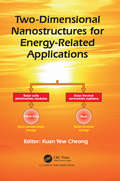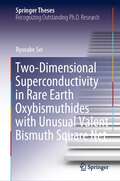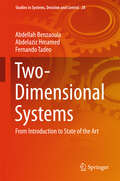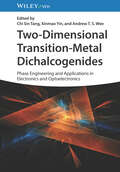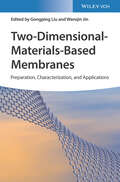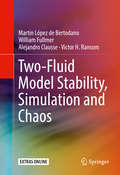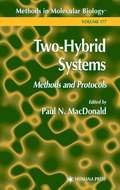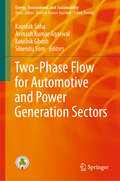- Table View
- List View
Two Sides of the Moon: Our Story of the Cold War Space Race
by David Scott Alexei LeonovWith a foreword by Neil Armstrong and an introduction by Tom HanksIn this unique dual autobiography, astronaut David Scott and cosmonaut Alexei Leonov recount their exceptional lives and careers spent on the cutting edge of science and space exploration. This book reveals, in a very personal way, the drama of one of the most ambitious contests ever embarked on by man, set against the conflict that once held the world in suspense: the clash between communism and Western democracy. Through the men’s memoirs, their courage emerges from their perseverance in times of extraordinary difficulty and danger.
Two Sides of the Moon: Our Story of the Cold War Space Race
by David Scott Alexei LeonovGrowing up on either side of the Iron Curtain, David Scott and Alexei Leonov experienced very different childhoods but shared the same dream to fly. Excelling in every area of mental and physical agility, Scott and Leonov became elite fighter pilots and were chosen by their countries' burgeoning space programs to take part in the greatest technological race ever-to land a man on the moon. In this unique dual autobiography, astronaut Scott and cosmonaut Leonov recount their exceptional lives and careers spent on the cutting edge of science and space exploration. With each mission fraught with perilous risks, and each space program touched by tragedy, these parallel tales of adventure and heroism read like a modern-day thriller. Cutting fast between their differing recollections, this book reveals, in a very personal way, the drama of one of the most ambitious contests ever embarked on by man, set against the conflict that once held the world in suspense: the clash between Russian communism and Western democracy.Before training to be the USSR's first man on the moon, Leonov became the first man to walk in space. It was a feat that won him a place in history but almost cost him his life. A year later, in 1966, Gemini 8, with David Scott and Neil Armstrong aboard, tumbled out of control across space. Surviving against dramatic odds-a split-second decision by pilot Armstrong saved their lives-they both went on to fly their own lunar missions: Armstrong to command Apollo 11 and become the first man to walk on the moon, and Scott to perform an EVA during the Apollo 9 mission and command the most complex expedition in the history of exploration, Apollo 15. Spending three days on the moon, Scott became the seventh man to walk on its breathtaking surface. Marking a new age of USA/USSR cooperation, the Apollo-Soyuz Test Project brought Scott and Leonov together, finally ending the Cold War silence and building a friendship that would last for decades. Their courage, passion for exploration, and determination to push themselves to the limit emerge in these memoirs not only through their triumphs but also through their perseverance in times of extraordinary difficulty and danger.
Two Studies in Gas-Phase Ion Spectroscopy
by Matthew J. SimpsonIn this thesis Matthew Simpson reportstwo areas of work in gas ion spectroscopy, each investigation in itself worthy of a PhD. The first study uses tunable vacuum-ultraviolet radiation from a synchrotron to identify negative ions from twenty four photoexcited polyatomic molecules in the gas phase. From these experiments, Matthew collects a vast amount of data and summarises and reviews ion-pair formation from polyatomic molecules. The second study is on selected ion flow tube mass spectrometry. Matthew investigates the reactions of cations and anions with ethene, monofluoroethene, 1,1-difluoroethene and tetrafluoroethene. In this study Matthew tries to explain why certain products are formed preferentially over other products at a microscopic level of understanding. The data recorded in this thesis form the most comprehensive collection of information about anion formation and are the basis of a review and numerous articles in specialist journals.
Two Truths and a Lie: Forces of Nature
by Laurie Ann Thompson Ammi-Joan PaquetteCrazy-but-true stories about the natural world make this acclaimed nonfiction series perfect for fans of curiosities and wonders—and anyone looking to explore ways to separate fact from fiction.Did you know studies have shown that too many fidget spinners spinning in the same direction can potentially have adverse effects on the earth’s magnetic field? Or that there’s a company that can turn your deceased loved one’s remains into a diamond? Or that the loudest sound in history was made by the eruption of a volcano in 1883, whose echoing blast circled the planet twice?Welcome to Two Truths and a Lie: Forces of Nature! You’ve heard of the game: Every story in this book is strange and astounding, but one out of every three is an outright lie. Picking out the fakes isn’t as easy as you think, however. Some false stories are based on truth, and some of the true stories are just plain unbelievable! Don’t be fooled by the photos that accompany each story—it’s going to take all your smarts and some clever research to ferret out the truth.From a man who gave himself an appendectomy to radio signals from other planets to eagles that have been trained to take out spy drones, the stories in this third installment in the Two Truths and a Lie series will amaze you! Just don’t believe everything you read. . . .
Two Truths and a Lie: Histories and Mysteries
by Laurie Ann Thompson Ammi-Joan PaquetteCrazy-but-true stories about history, geography, and human achievement make this acclaimed nonfiction series perfect for fans of curiosities and wonders. A fun way for middle graders to explore ways to separate fact from fiction.Did you know that a young girl once saved an entire beach community from a devastating tsunami thanks to something she learned in her fourth-grade geography lesson? Or that there is a person alive today who generates her own magnetic field? Or how about the fact that Benjamin Franklin once challenged the Royal Academy of Brussels to devise a way to make farts smell good?Welcome to Two Truths and a Lie: Histories and Mysteries! You know the game: Every story in this book is strange and astounding, but one out of every three is an outright lie.Can you guess which stories are the facts and which are the fakes? It’s not going to be easy. Some false stories are based on truth, and some of the true stories are just plain unbelievable! Don’t be fooled by the photos that accompany each story—it’s going to take all your smarts and some clever research to root out the alternative facts.From a train that transported dead people to antique photos of real fairies to a dog who was elected mayor, the stories in this book will amaze you! Just don’t believe everything you read. . . .
Two Truths and a Lie: It's Alive!
by Lisa K. Weber Laurie Ann Thompson Ammi-Joan PaquetteTwo Truths and a Lie is the first book in a fascinating new series that presents some of the most crazy-but-true stories about the living world as well as a handful of stories that are too crazy to be true—and asks readers to separate facts from the fakes! Did you know that there is a fungus that can control the mind of an ant and make it do its bidding? Would you believe there is such a thing as a corpse flower—a ten-foot-tall plant with a blossom that smells like a zombie? How about a species of octopus that doesn’t live in water but rather lurks in trees in the Pacific Northwest?Every story in this book is strange and astounding. But not all of them are real. Just like the old game in this book’s title, two out of every three stories are completely true and one is an outright lie. Can you guess which? It’s not going to be easy. Some false stories are based on truth, and some of the true stories are just plain unbelievable. And they’re all accompanied by dozens of photos, maps, and illustrations. Amaze yourself and trick your friends as you sort out the fakes from the facts!Acclaimed authors Ammi-Joan Paquette and Laurie Ann Thompson have teamed up to create a series of sneaky stories about the natural world designed to amaze, disgust, and occasionally bamboozle you.
Two from One: A Short Introduction to Cell Division Mechanisms
by Michael PolymenisTWO FROM ONE Condensed and easy step-in resource to the vast universe of cell cycle control and cell division Two from One: A Short Introduction to Cell Division Mechanisms is an easy and solid step-in for students and all individuals starting to learn about cell and molecular biology, as well as professionals looking for an avenue into the subject, emphasizing general concepts and universal aspects of eukaryotic cell division without getting lost in the vast amount of detail across the overall field. The text enables readers to learn about general concepts and discoveries from various systems and approaches to elucidate the process of cell division, with descriptions of scientific processes included throughout in order to aid in reader comprehension. The content and material have been taught, revised, and simplified based on student feedback, to be as accessible as possible to a broader audience. It can be read in a few hours by anyone with an interest in the topic and an undergraduate background. In Two from One, readers can expect to find coverage on a myriad of essential topics, such as: Cell theory, mitosis, chromosome theory of heredity, DNA, and why/how cell cycles come in many flavors Cell growth and division, covering balanced growth and cell proliferation, measures of cell growth, and the relationship between cell growth and division Assaying cell cycle progression, covering measuring cell cycle phases, single-cell imaging, labeled mitoses, and frequency distributions Duplicating the genome, covering DNA replication, origin firing, chromatin, checkpoints, and the DNA damage checkpoint Undergraduates, graduate students, and early career professionals in cell biology, biomedicine, and biology, along with post docs changing subject area or needing further information on cell division, will find Two from One to be an immensely useful, accessible, and reader-friendly resource in a traditionally highly complex field.
Two- and Three-Dimensional Flow of Groundwater
by Wouter Zijl Florimond De SmedtThis monograph is a practical guide to groundwater flow theory intended to serve students and practitioners by bridging the gap between basic hydrogeology and groundwater modeling. It synthesizes the mathematics of groundwater flow and provides information in an easily-accessible format for practicing groundwater professionals, consultants, and students that intend to become skillful and competent groundwater flow modelers.
Two-Dimensional (2D) NMR Methods
by K. Ivanov P. K. Madhu G. RajalakshmiTWO-DIMENSIONAL (2D) NMR METHODS Practical guide explaining the fundamentals of 2D-NMR for experienced scientists as well as relevant for advanced students Two-Dimensional (2D) NMR Methods is a focused work presenting an overview of 2D-NMR concepts and techniques, including basic principles, practical applications, and how NMR pulse sequences work. Contributed to by global experts with extensive experience in the field, Two-Dimensional (2D) NMR Methods provides in-depth coverage of sample topics such as: Basics of 2D-NMR, data processing methods (Fourier and beyond), product operator formalism, basics of spin relaxation, and coherence transfer pathways Multidimensional methods (single- and multiple-quantum spectroscopy), NOESY (principles and applications), and DOSY methods Multiple acquisition strategies, anisotropic NMR in molecular analysis, ultrafast 2D methods, and multidimensional methods in bio-NMR TROSY (principles and applications), field-cycling and 2D NMR, multidimensional methods and paramagnetic NMR, and relaxation dispersion experiments This text is a highly useful resource for NMR specialists and advanced students studying NMR, along with users in research, academic and commercial laboratories that study or conduct experiments in NMR.
Two-Dimensional (Springer Series on Polymer and Composite Materials)
by Rasel DasThis book covers newly emerging two-dimensional nanomaterials which have been recently used for the purpose of water purification. It focuses on the synthesis methods of 2D materials and answers how scientists/engineers/nanotechnologist/environmentalists could use these materials for fabricating new separation membranes and most probably making commercially feasible technology. The chapters are written by a collection of international experts ensuring a broad view of each topic. The book will be of interest to experienced researchers as well as young scientists looking for an introduction into 2D materials-based cross-disciplinary research.
Two-Dimensional Constant and Product Polynomial Systems
by Albert C. LuoThis book is a monograph about 1-dimensional flow arrays and bifurcations in constant and product polynomial systems. The 1-dimensional flows and the corresponding bifurcation dynamics are discussed. The singular hyperbolic and hyperbolic-secant flows are presented, and the singular hyperbolic-to-hyperbolic-secant flows are discussed. The singular inflection source, sink and upper, and lower-saddle flows are presented. The corresponding appearing and switching bifurcations are presented for the hyperbolic and hyperbolic-secant networks, and singular flows networks. The corresponding theorem is presented, and the proof of theorem is given. Based on the singular flows, the corresponding hyperbolic and hyperbolic-secant flows are illustrated for a better understanding of the dynamics of constant and product polynomial systems.
Two-Dimensional Electrophoresis Protocols
by David Sheehan Raymond TytherTwo-dimensional electrophoresis (2-DE) remains one of the most popular techniques for proteomic comparisons. Revolutionized by the development of immobilized pH gradient strips, this vital process has benefited greatly from recent developments in staining, mass spectrometry, and bioinformatics. In Two-Dimensional Electrophoresis Protocols, expert researchers examine these cutting edge proteomics methodologies, explore their application to a wide range of biological materials, and look at how these developments have helped standardize the design, execution, and analysis of proteomics experiments. Chapters reflect key steps in 2-DE experiments, including sample preparation, staining, post-translational modification, spot identification, and bioinformatics. Composed in the highly successful Methods in Molecular Biology series format, each chapter contains a brief introduction, step-by-step methods, a list of necessary materials, and a Notes section which shares tips on troubleshooting and avoiding known pitfalls. Innovative and reader-friendly, Two-Dimensional Electrophoresis Protocols encourages newcomers to apply powerful 2-DE techniques to their own research, while also providing current and essential information for seasoned scientists.
Two-Dimensional Liquid Chromatography: Principles and Practical Applications (SpringerBriefs in Molecular Science)
by Oliver JonesThis book addresses the growing interest in the field of two-dimensional liquid chromatography (2DLC), a powerful approach to increasing resolution, available peak capacity, and selectivity in analytical chromatography. 2DLC is suitable for many applications, including in the pharmaceutical and polymer industries and the omic sciences (metabolomics, lipidomics and proteomics). Thanks to recent advances in technology and software the instrumentation needed to perform 2D-LC is broadly available to the analytical community in both industry and academia. Indeed, the technique can now be considered ready for application in R&D as well as in QA and QC labs, yet it is not widely known about outside academic laboratories and is rarely taught at the undergraduate level. This book outlines the main principles and features of 2D-LC (including comprehensive and heart-cutting modes, method development and real world applications) to enable modern analysts to start using this fascinating technique. The book offers an ideal starting point for those wishing to get into 2D-LC and will also be of interest to more experienced scientists in the field.
Two-Dimensional Materials for Environmental Applications (Springer Series in Materials Science #332)
by Neeraj Kumar Suprakas Sinha Ray Rashi GusainThis book focuses on recent developments in the field of two-dimensional nanomaterials for environmental applications. Due to their high surface area and tunable surface chemistry, two-dimensional nanomaterials are currently garnering great interest for environmental remediation applications. This book compiles contributed chapters from active international researchers dealing with the development of state-of-the-art two-dimensional nanomaterials in environmental applications such as water and wastewater treatment, adsorption, photocatalysis, membrane separation, desalination, deionization, environmental pollutants sensing/detection, carbon-dioxide capture and catalytic conversion, microbial treatment, and electrochemical remediation. Each chapter provides an essential and comprehensive overview of the recent advances in material development and application, giving special attention to preparation methods, tunning of physiochemical properties, surface and interface chemistry, structural porosity, assemblies integration for fabrication of devices, and their relationship with overall efficiency. It offers a valuable reference guide for environmental and materials scientists, engineers, and policymakers working towards environmental sustainability.
Two-Dimensional Materials for Nonlinear Optics: Fundamentals, Preparation Methods, and Applications
by Qiang Wang; Hao-Li ZhangTwo-Dimensional Materials for Nonlinear Optics Comprehensive resource covering concepts, perspectives, and skills required to understand the preparation, nonlinear optics, and applications of two-dimensional (2D) materials Bringing together many interdisciplinary experts in the field of 2D materials with their applications in nonlinear optics, Two-Dimensional Materials for Nonlinear Optics covers preparation methods for various novel 2D materials, such as transition metal dichalcogenides (TMDs) and single elemental 2D materials, excited-state dynamics of 2D materials behind their outstanding performance in photonic devices, instrumentation for exploring the photoinduced excited-state dynamics of the 2D materials spanning a wide time scale from ultrafast to slow, and future trends of 2D materials on a series of issues like fabrications, dynamic investigations, and photonic/optoelectronic applications. Powerful nonlinear optical characterization techniques, such as Z-scan measurement, femtosecond transient absorption spectroscopy, and microscopy, are also introduced. Edited by two highly qualified academics with extensive experience in the field, Two-Dimensional Materials for Nonlinear Optics covers sample topics such as: Foundational knowledge on nonlinear optical properties, and fundamentals and preparation methods of 2D materials with nonlinear optical properties Modulation and enhancement of optical nonlinearity in 2D materials, and nonlinear optical characterization techniques for 2D materials and their applications in a specific field Novel nonlinear optical imaging systems, ultrafast time-resolved spectroscopy for investigating carrier dynamics in emerging 2D materials, and transient terahertz spectroscopy 2D materials for optical limiting, saturable absorber, second and third harmonic generation, nanolasers, and space use With collective insight from researchers in many different interdisciplinary fields, Two-Dimensional Materials for Nonlinear Optics is an essential resource for materials scientists, solid state chemists and physicists, photochemists, and professionals in the semiconductor industry who are interested in understanding the state of the art in the field.
Two-Dimensional Nanostructures for Energy-Related Applications
by Kuan Yew CheongThis edited book focuses on the latest advances and development of utilizing two-dimensional nanostructures for energy and its related applications. Traditionally, the geometry of this material refers to "thin film" or "coating." The book covers three main parts, beginning with synthesis, processing, and property of two-dimensional nanostructures for active and passive layers followed by topics on characterization of the materials. It concludes with topics relating to utilization of the materials for usage in devises for energy and its related applications.
Two-Dimensional Optical Spectroscopy
by Minhaeng ChoTwo-Dimensional Optical Spectroscopy discusses the principles and applications of newly emerging two-dimensional vibrational and optical spectroscopy techniques. It provides a detailed account of basic theory required for an understanding of two-dimensional vibrational and electronic spectroscopy. It also bridges the gap between the formal developm
Two-Dimensional Superconductivity in Rare Earth Oxybismuthides with Unusual Valent Bismuth Square Net (Springer Theses)
by Ryosuke SeiThis book elucidates fascinating electronic phenomena of unusual Bi2-square net in layered R2O2Bi (R: rare earth) compounds using two approaches: the fabrication of epitaxial thin films and the synthesis of bulk polycrystalline powders. The Bi2-square net compounds are a promising platform to explore exotic physical properties originating from the interplay between a two-dimensional electronic state and strong spin–orbit coupling; however, there are few reports on Bi2-square net compounds due to the instability of unusual electronic configurations. The book presents the development of synthetic routes for R2O2Bi compounds, such as novel solid phase epitaxy techniques and chemical control of crystal structure, demonstrating the intrinsic physical properties of Bi2-square net for the first time. The most notable finding is the successful induction of two-dimensional superconductivity in Bi2-square net with the coexistence of rich electronic phases. The book also discusses the superconducting mechanisms and the effect of R cation substitution in detail and describes the mechanical properties of Bi2-square net. These findings overturn the results of previous studies of R2O2Bi. The book sheds light on hidden layered compounds, representing a significant advance in the field.
Two-Dimensional Systems
by Abdellah Benzaouia Abdelaziz Hmamed Fernando TadeoA solution permitting the stabilization of 2-dimensional (2-D) continuous-time saturated system under state feedback control is presented in this book. The problems of delay and saturation are treated at the same time. The authors obtain novel results on continuous 2-D systems using the unidirectional Lyapunov function. The control synthesis and the saturation and delay conditions are presented as linear matrix inequalities. Illustrative examples are worked through to show the effectiveness of the approach and many comparisons are made with existing results. The second half of the book moves on to consider robust stabilization and filtering of 2-D systems with particular consideration being given to 2-D fuzzy systems. Solutions for the filter-design problems are demonstrated by computer simulation. The text builds up to the development of state feedback control for 2-D Takagi-Sugeno systems with stochastic perturbation. Conservatism is reduced by using slack matrices and the coupling between the Lyapunov matrix and the system matrices is broken by using basis-dependent Lyapunov functions. Mean-square asymptotic stability and prescribed H-infinity performance are guaranteed. Two-Dimensional Systems emphasizes practical approaches to control and filter design under constraints that appear in real problems and uses off-the-shelf software to achieve its results. Researchers interested in control and filter design for multidimensional systems, especially multi-dimensional fuzzy systems, will find this book a useful resource as will graduate students specializing in dynamical sytems.
Two-Dimensional Transition-Metal Dichalcogenides: Phase Engineering and Applications in Electronics and Optoelectronics
by Xinmao Yin Chi Sin Tang Andrew T. S. WeeTwo-Dimensional Transition-Metal Dichalcogenides Comprehensive resource covering rapid scientific and technological development of polymorphic two-dimensional transition-metal dichalcogenides (2D-TMDs) over a range of disciplines and applications Two-Dimensional Transition-Metal Dichalcogenides: Phase Engineering and Applications in Electronics and Optoelectronics provides a discussion on the history of phase engineering in 2D-TMDs as well as an in-depth treatment on the structural and electronic properties of 2D-TMDs in their respective polymorphic structures. The text addresses different forms of in-situ synthesis, phase transformation, and characterization methods for 2D-TMD materials and provides a comprehensive treatment of both the theoretical and experimental studies that have been conducted on 2D-TMDs in their respective phases. Two-Dimensional Transition-Metal Dichalcogenides includes further information on: Thermoelectric, fundamental spin-orbit structures, Weyl semi-metallic, and superconductive and related ferromagnetic properties that 2D-TMD materials possess Existing and prospective applications of 2D-TMDs in the field of electronics and optoelectronics as well as clean energy, catalysis, and memristors Magnetism and spin structures of polymorphic 2D-TMDs and further considerations on the challenges confronting the utilization of TMD-based systems Recent progress of mechanical exfoliation and the application in the study of 2D materials and other modern opportunities for progress in the field Two-Dimensional Transition-Metal Dichalcogenides provides in-depth review introducing the electronic properties of two-dimensional transition-metal dichalcogenides with updates to the phase engineering transition strategies and a diverse range of arising applications, making it an essential resource for scientists, chemists, physicists, and engineers across a wide range of disciplines.
Two-Dimensional-Materials-Based Membranes: Preparation, Characterization, and Applications
by Gongping LiuTwo-Dimensional-Materials-Based Membranes An authoritative and up to date discussion of two-dimensional materials and membranes In Two-Dimensional-Materials-Based Membranes: Preparation, Characterization, and Applications, a team of distinguished chemical engineers delivers a comprehensive exploration of the latest advances in design principles, synthesis approaches, and applications of two-dimensional (2D) materials—like graphene, metal-organic frameworks (MOFs), 2D layered double hydroxides, and MXene—and highlights the significance and development of these membranes. In the book, the authors discuss the use of membranes to achieve high-efficiency separation and to address the challenges posed in the field. The book also discusses potential challenges and benefits in the future development of advanced 2D nanostructures, as well as their impending implementation in applications in the fields of energy, sustainability, catalysis, electronics, and biotechnology. Readers will also find: A thorough introduction to fabrication methods for 2D-materials-based membranes, including the synthesis of nanosheets, membrane structures, and fabrication methods Descriptions of three types of 2D-materials-based membranes: single-layer membranes, laminar membranes and mixed-matrix membranes Comprehensive discussions of 2D-materials-based membranes for water and ions separation, solvent-water separation and gas separation Explorations of transport mechanism of 2D-materials-based membranes for molecular separations Perfect for membrane scientists, inorganic chemists, and materials scientists, Two-Dimensional-Materials-Based Membranes will also earn a place in the libraries of chemical and process engineers in industrial environments.
Two-Fluid Model Stability, Simulation and Chaos
by Martín López de Bertodano William Fullmer Alejandro Clausse Victor H. RansomThis book addresses the linear and nonlinear two-phase stability of the one-dimensional Two-Fluid Model (TFM) material waves and the numerical methods used to solve it. The TFM fluid dynamic stability is a problem that remains open since its inception more than forty years ago. The difficulty is formidable because it involves the combined challenges of two-phase topological structure and turbulence, both nonlinear phenomena. The one dimensional approach permits the separation of the former from the latter. The authors first analyze the kinematic and Kelvin-Helmholtz instabilities with the simplified one-dimensional Fixed-Flux Model (FFM). They then analyze the density wave instability with the well-known Drift-Flux Model. They demonstrate that the Fixed-Flux and Drift-Flux assumptions are two complementary TFM simplifications that address two-phase local and global linear instabilities separately. Furthermore, they demonstrate with a well-posed FFM and a DFM two cases of nonlinear two-phase behavior that are chaotic and Lyapunov stable. On the practical side, they also assess the regularization of an ill-posed one-dimensional TFM industrial code. Furthermore, the one-dimensional stability analyses are applied to obtain well-posed CFD TFMs that are either stable (RANS) or Lyapunov stable (URANS), with the focus on numerical convergence.
Two-Hybrid Systems
by Luis Oñate-SánchezThis detailed book explores the numerous applications of the yeast two-hybrid (Y2H) system, one of the most commonly used methods to detect protein-protein interactions. Beginning with an overview, the volume then continues by elucidating different methodologies to detect protein-protein interactions in yeast nucleus, membrane, cytoplasm, and bacteria, computational analyses of protein interaction networks, technical variations in yeast one-hybrid (Y1H) systems together with classical and more elaborated yeast methods to detect protein-DNA interactions, as well as protocols to analyze ternary protein interactions and RNA-protein and ligand-protein interactions. The book concludes with a section on methods in plant and mammalian cells that can be used to identify novel protein-protein and protein-DNA interactions and test (qualitatively and/or quantitatively) those observed in yeast. Written for the highly successful Methods in Molecular Biology series, chapters include the kind of detail and key implementation advice that leads to excellent results in the lab. Authoritative and practical, Two-Hybrid Systems: Methods and Protocols serves as an ideal guide to the uses of this exceedingly valuable technique.
Two-Hybrid Systems
by Paul N. MacdonaldPaul N. MacDonald has assembled a collection of powerful molecular tools for examining and characterizing protein-protein, protein-DNA, and protein-RNA interactions. The techniques range from the most basic (introducing plasmids into yeasts, interaction assays, and recovering the plasmids from yeast), to the most advanced alternative strategies (involving one-hybrid, split two-hybrid, three-hybrid, membrane recruitment systems, and mammalian systems). Methods are also provided for dealing with the well-known problem of artifacts and false positives and for identifying the interacting partners in important biological systems, including the SMAD and nuclear receptor pathways. To ensure ready reproducibility and robust results, each technique is described in step-by-step detail by researchers who employ it regularly.
Two-Phase Flow for Automotive and Power Generation Sectors (Energy, Environment, and Sustainability)
by Avinash Kumar Agarwal Kaushik Saha Koushik Ghosh Sibendu SomThis book focuses on the two-phase flow problems relevant in the automotive and power generation sectors. It includes fundamental studies on liquid–gas two-phase interactions, nucleate and film boiling, condensation, cavitation, suspension flows as well as the latest developments in the field of two-phase problems pertaining to power generation systems. It also discusses the latest analytical, numerical and experimental techniques for investigating the role of two-phase flows in performance analysis of devices like combustion engines, gas turbines, nuclear reactors and fuel cells. The wide scope of applications of this topic makes this book of interest to researchers and professionals alike.
